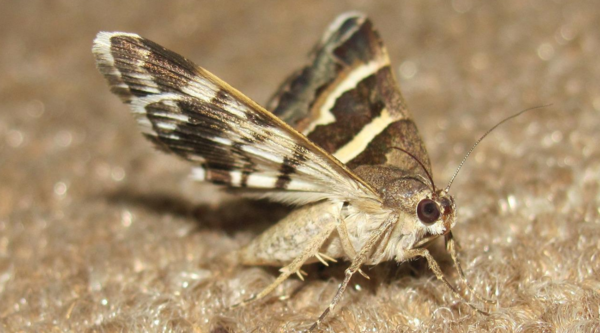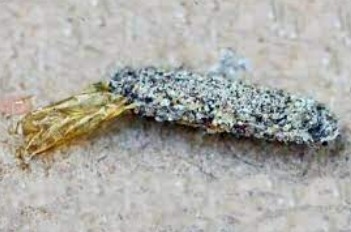
A moth infestation could put holes in your favorite sweater or leave larvae in the flour you need for baking cookies. Getting rid of moths is a top priority to make your home a clean and comfortable place.
You can get rid of moths with a thorough cleaning. Wash any clothes that could have been affected by moths in hot water. Throw away any open containers of food that moths could have entered. Clean around where you have spotted moths with a vacuum cleaner and a disinfecting wipe. Make sure you take anything that could have moth larvae on it out of your house.
If you fail to get every moth egg and larvae out of your house, they can quickly return. Read the rest of this article to make sure you get rid of moths the right way and prevent them from coming back.
You may also be interested in reading these two related articles “How To Get Rid Of Centipedes” and “How To Get Rid Of Cockroaches“.
Identify The Type Of Moth You Have
Two moths commonly live in homes: clothes moths and pantry moths. There are slight differences in how you get rid of these two moths. The two types can be identified by where you find them.
Clothes moths can be seen in your closets or where you store clothing. The first sign most people notice from clothes moths are holes in clothes. They can fly into your home looking for food from natural fibers, such as wool, linen, cotton or fur.
While pantry moths, sometimes called flour moths, appear near stored food like crackers, grains, cereal or rice. The first sign of pantry moths is often pupae, larvae and webs in your food, or tiny moths flying around your pantry. These invaders usually come to your house with store-bought food.
How To Kill Clothes Moths Eggs & Larvae

Clothes moths lay their eggs in your stored clothing. When the larvae hatch, they eat the clothing fibers, leaving holes. Killing the moths won’t stop the problem because in a few days, the eggs hatch, the larvae turn into moths and the life cycle starts over.
To start, inspect all of your clothing from the affected area, and anything that is too damaged should be thrown away. Everything that can be washed in hot water needs to be washed and dried on the hottest settings. Temperatures over 120 °F kill moth larvae, so your washing machine needs to have water at least that hot to do the job.
Clothes that can’t be washed in hot water can be dry cleaned or frozen for 10 days to kill larvae. On a hot, sunny day, leaving your clothes hanging in the sun for four to six hours might kill moth eggs and larvae.
Clean The Entire Area
You need to clean the entire area where you found evidence of moths. Vacuum every inch of closets. Be sure to get into crevices and cracks where eggs and larvae might be hiding. Wipe down any hard surfaces with vinegar or bleach.
Throw away anything you don’t need from the area. Everything you throw away needs to leave the house in case larvae or eggs survive. After vacuuming, empty the dust cup outside and wash it immediately.
It is a good idea to clean your whole house. Clothes moths can spread anywhere there is something to eat, and they could come back if you don’t get rid of them all. This might be an opportunity to have a cleaning company come and do a deep clean.
Getting Rid Of Pantry Moths
Start by emptying your food storage area and inspecting everything. Look for dead moths, eggs, larvae, webs, droppings or holes in packages. Anything with those signs of moths must be tossed.
Open jars and check under their lids. Moths sometimes lay eggs in between the lid rim and the jar top. After inspecting jars, wash them with a scrub brush under hot, soapy water.
All non-airtight containers with food inside need to be thrown out. Anything with an opening could have been contaminated with moths. Not throwing them away could make you sick or allow moths to reproduce and come back after cleaning.
Clean The Pantry Shelves
Vacuum the shelves, paying special attention to corners and gaps. Remove the shelves, if possible, and wipe them with a bleach or vinegar solution. Wipe the inside of the pantry with the same solution.
Go around your kitchen and clean up any food spills. Mop the floor with your bleach or vinegar solution. Everything you have thrown away needs to leave the house to prevent the moths from returning.
If you can, don’t restock the area you cleaned for a week or two to eliminate any food sources for moth larvae you missed. Also, if moths do return, they won’t ruin the new food.
How To Stop Moths From Returning
After you get rid of moths, you need to stop them from coming back. The biggest key to preventing moths from returning is maintaining a clean home.
Regular vacuuming makes your home less appealing to moths. Wiping fibers, crumbs and dust off surfaces eliminates food sources that could attract moths.
Seal Your House
Moths and other pests enter your home through any holes or cracks. Sealing as many holes as possible prevents moths from entering and creating a mess.
Weather sealing around doors and windows is critical. Check to make sure these seals are in working order and repair any that are not. The door sweep at the bottom of your outside doors is a critical barrier to stop moths from coming in.
Having working screens on your windows and doors keeps all insects, including moths, out of your house. If you don’t have every window and door screened, it could be time to consider doing it.
Check Items Before Bringing Them Into Your House
High-risk items include any dry food or clothing from a thrift shop. Examine these items well before you bring them home.
Check the dry food you buy at the store before putting it into your cart. If there is any sign of insects, put it back and consider choosing a different brand.
Wash or dry clean clothes you buy from second-hand stores before you bring them home. Antique items are especially likely to carry clothes moths and can be delicate to clean.
What Keeps Moths Away?
Some natural remedies might help to keep moths away from your house. You can make a natural repellant by filling a cloth bag with dried, crushed herbs, such as:
- Rosemary
- Thyme
- Cloves
- Lavender
- Bay Leaves
You can use one or a mixture of these herbs and hang the bag in your closet. Crushing the bag with your hand from time to time releases the oils in the herbs that repel moths. Spraying or diffusing the essential oils of these herbs also helps keep moths away.
Do Cedar Chests Keep Moths Away?
Cedar chests have long been thought to prevent moths from eating clothing. This belief is somewhat true, but it is most likely because a cedar chest is well sealed than from the cedar being an anti-moth agent.
Some cedar types contain oils that do repel moths and kill moth larvae. But the oils dissipate over time and lose their moth repellant effects.
Essential oil from Cedrus atlantica could be the best way of using cedar to repel moths. You could spray it into closets, rub the oils onto closet walls or coat hangers in the oil.
Should I Use Moth Balls To Get Rid Of Moths?
It’s pretty well agreed that the chemicals that make mothballs effective are dangerous for children, pets and you. You should only use mothballs as a last resort to kill moths.
Naphthalene and paradichlorobenzene are the main pesticides used in mothballs. California considers the chemicals known carcinogens, and the EU has banned naphthalene because it is a danger to public health.
Mothballs aren’t a preventative measure, but they will kill moths or larvae while they still release fumes. They leave a chemical smell on clothes and breathing in the fumes could be detrimental to your health.
Proper Storage Prevents Moths
Storing your clothes correctly makes it difficult for moths to attack them. Some tips for clothing storage include:
- Clean clothing before putting them in a closet.
- Store seasonal clothing in vacuum-sealed boxes or bags.
- Don’t store clothes in a humid, hot environment.
- Move clothes around in your closet.
Storing food in air-tight containers stops moths from making a home in it. When you buy dry goods that come in paper or plastic bags, you should put them in glass containers with air-tight lids when you get home.
Do Moth Traps Get Rid Of Moths
Some moth traps use pheromones to attract moths who then they get stuck on a sticky surface and die. Moth traps kill the living moths, but they don’t stop the larvae from growing up and continuing the moth life cycle.
Moth traps can help you to identify what type of moth you have, but they aren’t a way of completely eliminating moths from your home. You could use moth traps to alert you that there are moths in the house and you need to make efforts to get rid of them.